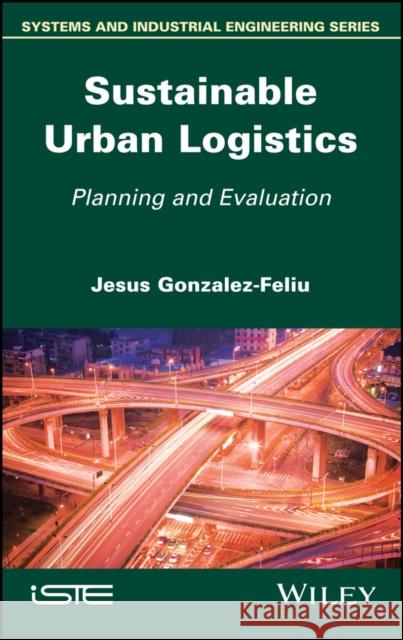Sustainable Urban Logistics: Planning and Evaluation » książka



Sustainable Urban Logistics: Planning and Evaluation
ISBN-13: 9781786301796 / Angielski / Twarda / 2018 / 304 str.
Sustainable Urban Logistics: Planning and Evaluation
ISBN-13: 9781786301796 / Angielski / Twarda / 2018 / 304 str.
(netto: 678,08 VAT: 5%)
Najniższa cena z 30 dni: 706,15
ok. 30 dni roboczych.
Darmowa dostawa!
Urban logistics has been a subject of interest to researchers and practitioners for more than 20 years in France and Europe, and more than 40 in the United States.
Wydanie ilustrowane
Preface ix
Chapter 1. Where Are We After 20 Years of Urban Logistics? 1
1.1. Introduction 1
1.2. The valorization of research in urban logistics: French and international approaches 7
1.3. From research to practice: a plethora of projects, initiatives and their practical application 14
1.3.1. France 23
1.3.2. Italy 25
1.3.3. Southern Europe (Spain, Greece, Portugal and other countries of Mediterranean Europe) 27
1.3.4. Germany 30
1.3.5. Belgium and the Netherlands 32
1.3.6. The United Kingdom 33
1.3.7. Northern Europe (Sweden, Norway, Finland and Denmark) 33
1.3.8. North America 34
1.3.9. Asia–Pacific Region 35
1.3.10. South America 36
1.3.11. Other regions of the world 37
1.4. Key questions in the quantitative and qualitative identification of urban logistics 38
Chapter 2. A Unified Definition of Sustainable Urban Logistics 43
2.1. The components of sustainability 43
2.2. The flows considered in urban freight transport 49
2.3. The stakeholders involved and their interests 52
2.3.1. Introduction 52
2.3.2. The urban logistics interests of these two categories of stakeholders 54
2.4. Visions for sustainable urban logistics 56
2.4.1. The main definitions of urban logistics 56
2.4.2. Vision of collective utility versus individual profitability 58
2.5. A unified definition of sustainable urban logistics 60
Chapter 3. The Evaluation, Assessment and Analysis of Scenarios as Decision–Making Tools 65
3.1. Assessment and evaluation in urban logistics: a body of work with little unification? 65
3.2. The role of scenario construction in assessments and evaluations 71
3.3. Before after assessments 73
3.4. Proposal of a methodological framework for the assessment and evaluation of the impacts of sustainable urban logistics 76
Chapter 4. Estimating Inter–establishment Flows 83
4.1. Data collection and modeling: close links but not homogeneous 83
4.2. Methodological proposal 94
4.3. Demand generation 96
4.4. Demand distribution models 101
4.5. The construction of routes and distances 106
Chapter 5. The Estimation of Other Urban Freight Transport Flows 121
5.1. Estimating end consumer and urban management flows: a topic less studied, but nevertheless more standardized 121
5.2. Estimating household purchasing activities 125
5.2.1. Some general information on household purchasing activities 125
5.2.2. Proposed methodology 132
5.2.3. Shopping trip generation 133
5.2.4. Distribution of purchase trips: the gravity model 137
5.2.5. Construction of shopping trip chains 139
5.3. Estimating delivery routes to households and delivery depots 143
5.4. Estimation of urban management flows 145
Chapter 6. Estimating and Modeling Change in Urban Logistics 147
6.1. Aims, goals and principles of modeling change in urban logistics 147
6.2. Examples of assessments and analyses using change modeling 151
6.2.1. Modeling the changes induced by the introduction of the SimplyCité UCC to Saint–Étienne 151
6.2.2. Modeling the change(s) brought about by restricting access to the city center 154
6.2.3. Modeling the change brought about by new forms of e–commerce 156
6.3. Generalizing the examples of overall change modeling framework 157
6.4. The importance of solution probleming in change analysis 159
Chapter 7. Indicators and Dashboards for the Evaluation of Sustainable Urban Logistics 165
7.1. The need to evaluate sustainable urban logistics for the definition of dashboards 165
7.2. Methodological proposals 168
7.2.1. The expert network method 171
7.2.2. The co–constructive consensus method 173
7.3. Examples of use 177
7.4. Inputs and limitations of the proposed methodology 182
Chapter 8. Estimating the Impact of Sustainable Urban Logistics 185
8.1. Introduction 185
8.2. Economic evaluation 186
8.2.1. Estimating the direct costs of transportation and storage 187
8.2.2. Analysis of margin on variable costs 189
8.2.3. Cost benefit analysis 193
8.2.4. Example uses of economic valuation methods 198
8.3. Methods for estimating environmental impacts 205
8.3.1. Main methods for estimating environmental impacts 205
8.3.2. Introduction to life cycle analysis 207
8.4. Spatial indicators: centrality, inequality, attractiveness and accessibility 213
8.4.1. Service level indicators 214
8.4.2. Distance and cost indicators 216
8.4.3. Gravitational indicators 217
8.5. Practical considerations of indicator estimation methods 220
Conclusion 225
Bibliography 231
Index 279
1997-2026 DolnySlask.com Agencja Internetowa
KrainaKsiazek.PL - Księgarnia Internetowa









